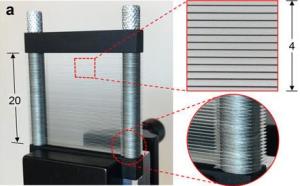Jul 20 2017
Researchers at the Brown University have formulated a new technique of controlling the polarization of light at terahertz frequencies.
 Polarized - Researchers have used a new technique to create a polarizing beamsplitter for terahertz waves. (Credit: Mittleman lab / Brown University)
Polarized - Researchers have used a new technique to create a polarizing beamsplitter for terahertz waves. (Credit: Mittleman lab / Brown University)
The method employs stacks of meticulously spaced metal plates to form a polarizing beamsplitter, a device that splits a beam of light by its varying polarization states, transmitting vertically polarized light in one direction and horizontally polarized light in the other direction. Such a beamsplitter could be beneficial in a wide range of systems that utilize terahertz radiation, from imaging systems to prospective communications networks.
In the imaging domain, the ability to deliver and detect radiation at diverse polarizations could be beneficial in terahertz microscopy and material characterization. In communications, polarized beams can enable numerous data streams to be conveyed down the same medium without hindrance.
This stack-of-plates idea has advantages over traditional methods of manipulating polarization in the terahertz region. It’s cheaper and physically more robust than other methods, and it’s more versatile in what it allows us to do.
Dan Mittleman, a Professor in Brown’s School of Engineering and Senior Author of a research paper
Rajind Mendis, a Research Assistant Professor at Brown, headed the research together with Mittleman, Brown Graduate Student Wei Zhang and Masaya Nagai, an Associate Professor at Osaka University in Japan.
The terahertz range is the swath of the electromagnetic spectrum found between infrared and microwave frequencies. Application of terahertz waves in technological applications such as spectroscopy, imaging, sensing and ultra-high-bandwidth communications is increasing, and Researchers are aiming to create the hardware components essential to construct these advanced terahertz systems.
Polarization denotes the orientation of an electromagnetic wave’s peaks and valleys as the wave spreads. If a wave is spreading toward one point, the peaks and valleys can be oriented horizontally, vertically or anywhere in between.
Polarization is one of the key properties of any electromagnetic wave. Being able to manipulate polarization — to measure it or to change it — is one of the important capabilities you need in any electromagnetic system.
Dan Mittleman, a Professor in Brown’s School of Engineering and Senior Author of a research paper
In the visible light realm, for instance, controlling polarization is used to produce latest 3D movies and to make sunglasses that minimize the glare of reflected light. Polarizing sunglasses are created by organizing polymer strands in a horizontal manner within lenses like bars on a jail cell. Those strands allow light that is polarized vertically to pass through, while obstructing horizontally polarized light, which is the main polarization state of light reflected off shiny surfaces like water and cars.
Current techniques of controlling polarization in the terahertz range are quite similar to the method used in polarizing sunglasses, although scaled to the much longer wavelengths of terahertz light than to visible light. Polarizing filters for terahertz are usually an array of metal wires a few microns in diameter and spaced some microns apart.
The new method the Brown and Osaka team came up with replaces the wires with a stack of closely-spaced steel plates. Each pair of plates develops what is known as a parallel-plate waveguide. When terahertz light is shined on the stack at a 45 degree angle, it divides the beam by exciting two waveguide modes. One beam of vertically polarized light passes directly through the device, while the other beam of horizontally polarized light is reflected in a 90 degree angle from the original beam axis.
The method has many advantages compared to traditional wire filters, the Researchers say. The stack-of-plates architecture, which is called as an “artificial dielectric,” is simple to make, and the materials are not costly. The plates are also a lot less fragile than wires.
“The artificial-dielectric concept also makes the device more versatile,” Mendis said. “The device can be easily tuned for use at different terahertz frequencies simply by changing the size of the spacers separating the plates or by changing the illuminating angle.”
Another plus is that with the incorporation of a second similar artificial-dielectric structure, the researchers were able to form a device called an isolator. Isolators are used on high-powered lasers to stop light from being reflected back into a laser emitter, which could weaken or even destroy it. A terahertz isolator could be a vital component for future high-powered terahertz devices.
The Brown and Osaka team is in the process of patenting the new artificial-dielectric devices, and the researchers are optimistic that these devices will facilitate the development of new terahertz systems with much better capabilities.
In anything you might want to do with an optical system, it’s useful to be able to manipulate polarization. This is a simple, efficient, effective and versatile way to do that.
Dan Mittleman, a Professor in Brown’s School of Engineering and Senior Author of a research paper
The research was supported partially by the National Science Foundation (EPMD #1609521).